View in other NatureServe Network Field Guides
NatureServe
Montana
Utah
Wyoming
Idaho
Wisconsin
British Columbia
South Carolina
Yukon
California
New York
Thicket Hairstreak - Callophrys spinetorum
General Description
[From Ferris and Brown 1981; Scott 1986; Opler and Wright 1999; Glassberg 2001; Pyle 2002] Forewing 1.4-1.5 cm. Double-tailed (posterior tail longer, both white-tipped), fringes white. Upperside steel-blue with faint iridescent sheen, broad black borders; underside reddish brown, forewing with a white cell-end bar, hindwing with a continuous white postmedian band edged inwardly with black and forming a W near tails, usually with a series of small black submarginal points or chevrons with orange caps and blue bottoms.
Phenology
One flight, mostly June northward; several flights, March to August southward (Scott 1986). May to July in one flight areas, March to September in two flight areas (Glassberg 2001). Early May to late July in Colorado (Scott and Scott 1978), late April to late August in Oregon and Washington (Pyle 2002), early May to mid-August in Oregon (Warren 2005), late April to mid-July in British Columbia (Guppy and Shepard 2001).
Diagnostic Characteristics
Best determined by combination of reddish-brown undersurface combined with steel-blue uppersurface, presence of tails, undersurface of hindwing with a white postmedian band forming a W near tails, usually with a series of small black submarginal points or chevrons with orange caps and blue bottoms.
Species Range
Montana Range
Range Descriptions
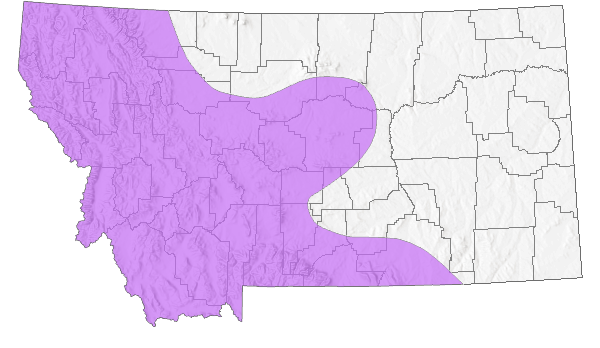
 Native
Native
Range Comments
Southern British Columbia and Alberta south to northern Baja California and northern Sierra Madre of western Mexico, east to eastern Montana, Colorado, New Mexico, and western Texas (Scott 1986; Opler and Wright 1999; Glassberg 2001); 1830 m to 3050 m elevation in the Rocky Mountain states (Ferris and Brown 1981), 1890 m to 3353 m elevation in Colorado (Brown 1957; Shields 1965; Scott and Scott 1978), 427 m to at least 2134 m elevation in Oregon (Warren 2005), up to 1000 m elevation in British Columbia (Threatful 1988; Guppy and Shepard 2001). In Montana, 853 m to 2355 m elevation in the mountainous western 1/3 of the state (Shields 1965; Kohler 1980; Stanford and Opler 1993; FLMNH Lepidopterists' Society database). Uncommon to common in most of the Rocky Mountains, rare west of the Rockies and in Alberta (Glassberg 2001).
Observations in Montana Natural Heritage Program Database
Number of Observations: 9
(Click on the following maps and charts to see full sized version)
Map Help and Descriptions
Relative Density
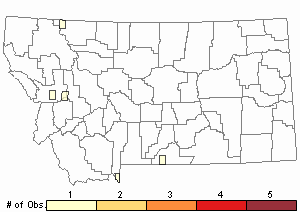
Recency
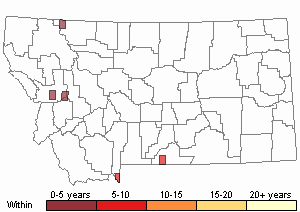
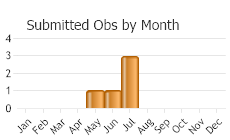
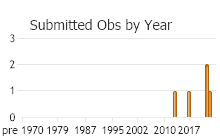
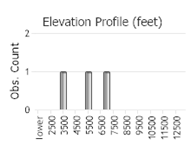 (Observations spanning multiple months or years are excluded from time charts)
(Observations spanning multiple months or years are excluded from time charts)
Migration
Non-migratory.
Habitat
Foothill and montane conifer forest, low to high elevation forest clearings, roadsides (Opler and Wright 1999; Glassberg 2001; Guppy and Shepard 2001; Pyle 2002). In Glacier National Park, Montana reported from montane wet meadows (Debinski 1993); other Montana localities include several in montane mixed-conifer forest (Shields 1965).
Food Habits
Larval food plants include several species of Arceuthobium, which are parasitic on species of Pinaceae (Shields 1965; Scott and Scott 1978; Ferris and Brown 1981; Scott 1986; Pyle 2002; Warren 2005). Adults feed on flower nectar (including Achillea, Allium, Anaphalis, Antennaria, Arctostaphylos, Asclepias, Berberis, Ceanothus, Cymopterus, Erigeron, Eriodictyon, Eriogonum, Fragaria, Helenium, Iris, Lomatium, Lupinus, Melilotus, Polygonum, Potentilla, Prunus, Pseudocymopterus, Rhus, Ribes, Sedum, Taraxacum, Salix, Sambucus, Senecio, Solidago, Spraguea) and mud (Shields 1965; James and Nunnallee 2011; Scott 2014).
Reproductive Characteristics
Females lay eggs singly in deep crevices on host plant (Scott 1986; James and Nunnallee 2011). Eggs hatch in about 7 days (depending on temperature), develop from L1 instar to L4 instar and pupate in about 29 days. Pupae overwinter in trees; some adults may eclose (emerge from pupae) in about 21 days without overwintering as pupae (Scott 1979; Pyle 2002; James and Nunnallee 2011). Larvae solitary, feed on host buds and fruiting heads, may be tended by ants (Formica pilicornis in captivity), build no nests (Scott 1986; Ballmer and Pratt 1991; James and Nunnallee 2011). Males perch throughout the day, especially in the crowns of hilltop trees, to await females (Scott 1975b, 1986).
Stewardship Responsibility
References
- Literature Cited AboveLegend:
 View Online Publication
View Online Publication Ballmer, G.R. and G.F. Pratt. 1991. Quantification of ant attendance (myrmecophily) of lycaenid larvae. Journal of Research on the Lepidoptera 30(1-2): 95-112.
Ballmer, G.R. and G.F. Pratt. 1991. Quantification of ant attendance (myrmecophily) of lycaenid larvae. Journal of Research on the Lepidoptera 30(1-2): 95-112. Brown, F.M. 1957. Colorado Butterflies. Proceedings; Numbers Three through Seven. Denver Museum of Natural History, Denver, Co.
Brown, F.M. 1957. Colorado Butterflies. Proceedings; Numbers Three through Seven. Denver Museum of Natural History, Denver, Co. Debinski, D. 1993. Butterflies of Glacier National Park, Montana. Occasional Papers of the Museum of Natural History, the University of Kansas, Lawrence, Kansas. No. 159: 1-13.
Debinski, D. 1993. Butterflies of Glacier National Park, Montana. Occasional Papers of the Museum of Natural History, the University of Kansas, Lawrence, Kansas. No. 159: 1-13. Ferris, C.D. and F.M. Brown (eds). 1981. Butterflies of the Rocky Mountains. Univ. of Oklahoma Press. Norman. 442 pp.
Ferris, C.D. and F.M. Brown (eds). 1981. Butterflies of the Rocky Mountains. Univ. of Oklahoma Press. Norman. 442 pp. Glassberg, J. 2001. Butterflies through Binoculars: A Field Guide to the Butterflies of Western North America. Oxford University Press.
Glassberg, J. 2001. Butterflies through Binoculars: A Field Guide to the Butterflies of Western North America. Oxford University Press. Guppy, C.S. and J.H. Shepard. 2001. Butterflies of British Columbia: including western Alberta, southern Yukon, the Alaska Panhandle, Washington, northern Oregon, northern Idaho, northwestern Montana. UBC Press (Vancouver, BC) and Royal British Columbia Museum (Victoria, BC). 414 pp.
Guppy, C.S. and J.H. Shepard. 2001. Butterflies of British Columbia: including western Alberta, southern Yukon, the Alaska Panhandle, Washington, northern Oregon, northern Idaho, northwestern Montana. UBC Press (Vancouver, BC) and Royal British Columbia Museum (Victoria, BC). 414 pp. James, D.G. and D. Nunnallee. 2011. Life histories of Cascadia butterflies. Corvallis, OR: Oregon State University Press. 447 p.
James, D.G. and D. Nunnallee. 2011. Life histories of Cascadia butterflies. Corvallis, OR: Oregon State University Press. 447 p. Kohler, S. 1980. Checklist of Montana Butterflies (Rhopalocera). Journal of the Lepidopterists' Society 34(1): 1-19.
Kohler, S. 1980. Checklist of Montana Butterflies (Rhopalocera). Journal of the Lepidopterists' Society 34(1): 1-19. Opler, P.A. and A.B. Wright. 1999. A field guide to western butterflies. Second edition. Peterson Field Guides. Houghton Mifflin Company, Boston, Massachusetts. 540 pp.
Opler, P.A. and A.B. Wright. 1999. A field guide to western butterflies. Second edition. Peterson Field Guides. Houghton Mifflin Company, Boston, Massachusetts. 540 pp. Pyle, R.M. 2002. The butterflies of Cascadia: a field guide to all the species of Washington, Oregon, and surrounding territories. Seattle Audubon Society, Seattle, Washington. 420 pp.
Pyle, R.M. 2002. The butterflies of Cascadia: a field guide to all the species of Washington, Oregon, and surrounding territories. Seattle Audubon Society, Seattle, Washington. 420 pp. Scott, J.A. 1975b. Mate-locating behavior of western North American butterflies. Journal of Research on the Lepidoptera 14:1-40.
Scott, J.A. 1975b. Mate-locating behavior of western North American butterflies. Journal of Research on the Lepidoptera 14:1-40. Scott, J.A. 1979. Hibernal diapause of North American Papilionoidea and Hesperioidea. Journal of Research on the Lepidoptera 18(3): 171-200.
Scott, J.A. 1979. Hibernal diapause of North American Papilionoidea and Hesperioidea. Journal of Research on the Lepidoptera 18(3): 171-200. Scott, J.A. 1986. The butterflies of North America: a natural history and field guide. Stanford University Press, Stanford, California.
Scott, J.A. 1986. The butterflies of North America: a natural history and field guide. Stanford University Press, Stanford, California. Scott, J.A. 2014. Lepidoptera of North America 13. Flower visitation by Colorado butterflies (40,615 records) with a review of the literature on pollination of Colorado plants and butterfly attraction (Lepidoptera: Hersperioidea and Papilionoidea). Contributions of the C.P. Gillette Museum of Arthopod Diversity. Fort Collins, CO: Colorado State University. 190 p.
Scott, J.A. 2014. Lepidoptera of North America 13. Flower visitation by Colorado butterflies (40,615 records) with a review of the literature on pollination of Colorado plants and butterfly attraction (Lepidoptera: Hersperioidea and Papilionoidea). Contributions of the C.P. Gillette Museum of Arthopod Diversity. Fort Collins, CO: Colorado State University. 190 p. Scott, J.A. and G.R. Scott. 1978. Ecology and distribution of the butterflies of southern central Colorado. Journal of Research on the Lepidoptera 17(2): 73-128.
Scott, J.A. and G.R. Scott. 1978. Ecology and distribution of the butterflies of southern central Colorado. Journal of Research on the Lepidoptera 17(2): 73-128. Shields, O. 1965. Callophrys (Mitoura) spinetorum and C. (M.) johnsoni: their known range, habits, variation, and history. Journal of Research on the Lepidopters 4(4): 233-250.
Shields, O. 1965. Callophrys (Mitoura) spinetorum and C. (M.) johnsoni: their known range, habits, variation, and history. Journal of Research on the Lepidopters 4(4): 233-250. Stanford, R.E. and P.A. Opler. 1993. Atlas of western USA butterflies: including adjacent parts of Canada and Mexico. Unpubl. Report. Denver and Fort Collins, Colorado 275 pp.
Stanford, R.E. and P.A. Opler. 1993. Atlas of western USA butterflies: including adjacent parts of Canada and Mexico. Unpubl. Report. Denver and Fort Collins, Colorado 275 pp. Threatful, D.L. 1988. A list of the butterflies and skippers of Mount Revelstoke and Glacier National Parks, British Columbia, Canada (Lepidoptera). Journal of Research on the Lepidoptera 27(3-4): 213-221.
Threatful, D.L. 1988. A list of the butterflies and skippers of Mount Revelstoke and Glacier National Parks, British Columbia, Canada (Lepidoptera). Journal of Research on the Lepidoptera 27(3-4): 213-221. Warren, A.D. 2005. Lepidoptera of North America 6: Butterflies of Oregon, their taxonomy, distribution, and biology. Contributions of the C. P. Gillette Museum of Arthropod Diversity, Colorado State University. Fort Collins, Colorado. 406 pp.
Warren, A.D. 2005. Lepidoptera of North America 6: Butterflies of Oregon, their taxonomy, distribution, and biology. Contributions of the C. P. Gillette Museum of Arthropod Diversity, Colorado State University. Fort Collins, Colorado. 406 pp.
- Additional ReferencesLegend:
 View Online Publication
View Online Publication
Do you know of a citation we're missing? Allen, T.J., J.P. Brock, and J. Glassberg. 2005. Caterpillars in the field and garden: a field guide to the butterfly caterpillars of North America. Oxford University Press.
Allen, T.J., J.P. Brock, and J. Glassberg. 2005. Caterpillars in the field and garden: a field guide to the butterfly caterpillars of North America. Oxford University Press. Brock, J.P. and K. Kaufman. 2003. Kaufman Field Guide to Butterflies of North America. Houghton Mifflin Company, New York, NY 284 pp.
Brock, J.P. and K. Kaufman. 2003. Kaufman Field Guide to Butterflies of North America. Houghton Mifflin Company, New York, NY 284 pp. Debinski, D. M. 1991. Inventory and monitoring of biodiversity: an assessment of methods and a case study of Glacier National Park, MT. Ph.D. Dissertation. Montana State University, Bozeman. 205 p.
Debinski, D. M. 1991. Inventory and monitoring of biodiversity: an assessment of methods and a case study of Glacier National Park, MT. Ph.D. Dissertation. Montana State University, Bozeman. 205 p. Forister, M.L., C.A. Halsch, C.C. Nice, J.A. Fordyce, T.E. Dilts, J.C. Oliver, K.L. Prudic, A.M. Shapiro, J.K. Wilson, J. Glassberg. 2021. Fewer butterflies seen by community scientists across the warming and drying landscapes of the American West. Science 371:1042-1045.
Forister, M.L., C.A. Halsch, C.C. Nice, J.A. Fordyce, T.E. Dilts, J.C. Oliver, K.L. Prudic, A.M. Shapiro, J.K. Wilson, J. Glassberg. 2021. Fewer butterflies seen by community scientists across the warming and drying landscapes of the American West. Science 371:1042-1045. Forister, M.L., E.M. Grames, C.A. Halsch, K.J. Burls, C.F. Carroll, K.L. Bell, J.P. Jahner, et al. 2023. Assessing risk for butterflies in the context of climate change, demographic uncertainty, and heterogeneous data sources. Ecological Monographs 93(3):e1584. https://doi.org/10.1002/ecm.1584
Forister, M.L., E.M. Grames, C.A. Halsch, K.J. Burls, C.F. Carroll, K.L. Bell, J.P. Jahner, et al. 2023. Assessing risk for butterflies in the context of climate change, demographic uncertainty, and heterogeneous data sources. Ecological Monographs 93(3):e1584. https://doi.org/10.1002/ecm.1584 Fultz, J.E. 2005. Effects of shelterwood management on flower-visiting insects and their floral resources. M.Sc. Thesis. Bozeman, MT: Montana State University. 163 p.
Fultz, J.E. 2005. Effects of shelterwood management on flower-visiting insects and their floral resources. M.Sc. Thesis. Bozeman, MT: Montana State University. 163 p. Layberry, R.A., P.W. Hall, and J.D. LaFontaine. 1998. The Butterflies of Canada. University of Toronto Press. 280 pp. + color plates.
Layberry, R.A., P.W. Hall, and J.D. LaFontaine. 1998. The Butterflies of Canada. University of Toronto Press. 280 pp. + color plates. Maxell, B.A. 2016. Northern Goshawk surveys on the Beartooth, Ashland, and Sioux Districts of the Custer-Gallatin National Forest: 2012-2014. Montana Natural Heritage Program. Helena, MT. 114pp.
Maxell, B.A. 2016. Northern Goshawk surveys on the Beartooth, Ashland, and Sioux Districts of the Custer-Gallatin National Forest: 2012-2014. Montana Natural Heritage Program. Helena, MT. 114pp. McLeod, L. 2006. An aberration of Chrysoritis pan (Pennington, 1962) (Lepidoptera: Lycaenidae). Metamorphosis : Journal of the Lepidopterists' Society of Africa. 17, 50.
McLeod, L. 2006. An aberration of Chrysoritis pan (Pennington, 1962) (Lepidoptera: Lycaenidae). Metamorphosis : Journal of the Lepidopterists' Society of Africa. 17, 50. Opler, P.A., K. Lotts, and T. Naberhaus, coordinators. 2010. Butterflies and moths of North America. Big Sky Institute, Bozeman, MT. Available at: www.butterfliesandmoths.org (Accessed 15 June 2015).
Opler, P.A., K. Lotts, and T. Naberhaus, coordinators. 2010. Butterflies and moths of North America. Big Sky Institute, Bozeman, MT. Available at: www.butterfliesandmoths.org (Accessed 15 June 2015).
- Web Search Engines for Articles on "Thicket Hairstreak"
- Additional Sources of Information Related to "Insects"





